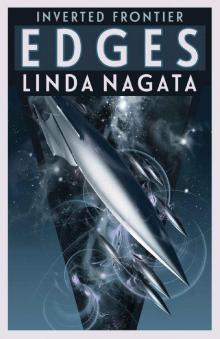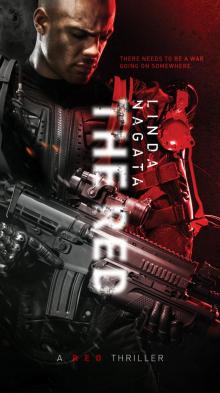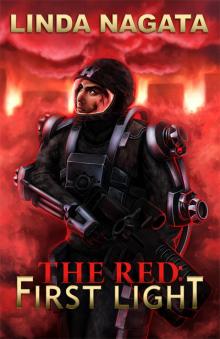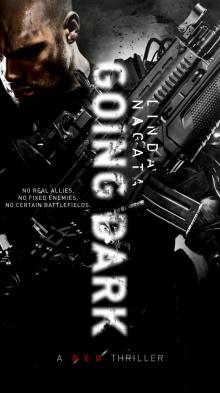- Home
- Linda Nagata
Going Dark Page 2
Going Dark Read online
Page 2
“Conditions are as forecast, sir. The ice pack at this location is estimated at thirteen centimeters, enough to support your weight, with gear. Temperature is minus thirty-nine degrees Fahrenheit, wind speed between forty-six and fifty knots, heavily overcast, with wind-driven snow flurries.”
We are not going to be hot much longer.
I feel the deck tilt and gently rock under me, then a shattering crackle as we break through the crust.
My helmet picks up and enhances the faint voice of the sub’s commander speaking to the lieutenant through her headset as he gives her clearance to open the hatch. She scrambles up the ladder, works the mechanism, and then shoves the hatch open, bracing it against the wind before sliding back down. I glance up at a circle as black as our visors. It is 1400 UTC. The date is December 23. The sun won’t look on this latitude again for months to come, and at this moment in the long winter night, storm clouds have smothered even the starlight.
I focus my mind on a well-rehearsed command: Move out. My skullnet is trained to recognize neural patterns associated with common words and commands. It picks up the thought, translating it to a flat, synthesized version of my voice so that I hear myself say the words over gen-com. “Move out.”
Lieutenant Logan takes the lead. Leaving the folded frame of his dead sister, he is first up the ladder. Escamilla follows. Dunahee and Tran work together to hand up the dead sisters and then a telescoping gangplank provided by the navy lieutenant. They follow the gear out to the hull. Julian, Roman, and Fadul go after them. I’m next, with the navy lieutenant coming last.
The wind hits with vicious force as I reach the top of the ladder. It’s like a negative pressure, emptying my lungs. I have to force myself to breathe as the ferocious cold ignites a searing pain in my throat.
My helmet adjusts faster than I do. My visor shifts to night vision, while the audio system filters out the wind’s roar, allowing me to hear the crunch of boots and a glassy clinking as the sub drifts against shards of broken ice.
I climb out, joining my squad on the narrow dorsal hull. A few steps away, the fin-shaped sail, studded with masts housing communications and surveillance systems, stands tall against a stormy sky.
My own communications system wakes up. The satellite relay in my pack links automatically to our secure channel and a new icon flares on my display. “Confirm contact established,” the rich, soft-edged voice of my commanding officer instructs. Major William Kanoa used to be squad CO, but our physician refused to recertify him for field duty after a spinal injury. Now he’s my remote handler.
“Contact confirmed,” I respond as I watch Logan and Escamilla deploy the gangplank—a twenty-centimeter-wide bridge to the unbroken floe. “We are on schedule and transitioning to the ice.” But then, because missions sometimes get scrubbed at the last minute, I ask, “We holding steady with the mission plan?”
“Roger that. Sigil remains the target. We need to know what’s going on inside its labs—”
I flinch hard as the hatch bangs shut behind me. PTSD. My heart rate spikes and I have to fight the urge to swing around with my HITR raised and ready to fire. I don’t want to scare the navy lieutenant as she steps past me to check the gangplank.
In the corner of my vision, an icon brightens. It’s an intricate red mesh glowing against a black circle—my skullnet icon—its glow indicating a burst of activity in the mesh of wires in my head, signals sent to my brain to trigger neurochemicals that push me back toward a calm emotional center.
I rarely see the skullnet icon anymore and it irritates me to see it now. I don’t need a cerebral nanny always watching over me anymore. I’ve learned to handle my own emotions.
After a second, it goes away.
“There is a problem,” Kanoa says. His tone has changed; it’s become softer, more soothing. That tells me he noticed my emotional spike, and that irritates me too.
“What problem?” I ask as Fadul moves first across the bridge.
“Oscar-1 is behind schedule. Fuel issues. There’s going to be a delay in your extraction.”
Oscar-1 is Jason Okamoto, an ex–air force pilot who has pulled us out of a couple of nasty situations. He’s scheduled to pick us up in ETM 7-1’s little nine-passenger tiltrotor when we’re ready to withdraw.
“How far behind schedule?” I ask. Fadul reaches solid ice without incident. She unhooks from her safety line. Logan hooks the other end to one of the dead sisters. “Is he out of the game?”
“Undetermined, but we’re looking at alternate means if he can’t get through.”
“Roger that.”
I don’t like it, but extraction was always going to be the hardest part of Palehorse Keep, and I trust Kanoa to find a way to get us out.
I watch the folded dead sister slide down the gangplank, secured between two lines. When it’s safely across, Logan hauls the lines back and with the navy lieutenant’s help, he sets up to send another.
While they get our gear transferred, I make a slow turn, letting my helmet cams record a night vision perspective of the surrounding ice field.
We are four hundred kilometers north of Canada’s Ellesmere Island and only three hundred seventy kilometers from the North Pole. Immediately around us, green-tinted flurries of wind-driven snow skitter across a channel of smooth ice. But half a klick out, the floe becomes a badland of broken blocks heaved up and tumbled together.
Kanoa says, “The ice has been shifting. I’m sending a revised map.”
“Roger that. Any additional intelligence on the target?”
“Negative. No electronic traffic.”
Kanoa saved my life the night I returned to Earth. He pulled me out of the cold water of the Pacific and when I stopped shivering, he offered me a chance to make a difference, to be part of the ETM strike force, a ghost unit that executes missions determined by the Red. Sometimes it’s hard to forgive him for that—for giving me that choice.
The dead sisters have all been moved to the ice. The squad crosses next, each soldier hooking up to the safety lines before transiting the bobbing gangplank. By the time I cross, the surface has refrozen. It looks solid, though I know it’s not. I walk quickly but carefully across the little bridge, relying on the lieutenant to pull me out if I slip.
I don’t slip.
I reach the floe and unhook. The safety line snakes back, and then the lieutenant works to pull back the gangplank, one segment at a time. Around me, backpacks drop to the ice, and the dead sisters get unfolded.
I expand the new map in my visor’s display. It shows our target to the south-southeast, only five kilometers away. The sub’s sensors picked up no sign of enemy forces close at hand, but we are not safe. Even in this wind, a skilled sniper could hit us from five hundred meters out. Maybe farther. As I turn my head, the gale claws past the edge of my helmet in a skin-crawling key.
“Dunahee! Get the angel in the air.” I need to see farther. I need a real-time view of what’s out there. “And make goddamn sure you keep the angel on a tether.”
“Roger that, sir!”
Dunahee is already halfway into his rig, an operation made faster by Roman, who is helping him secure the cinches.
Rosanna Roman is our designated marksman. She’s as tall as Fadul but more willowy. Behind her visor, her eagle eyes are blue, her hair light brown. On Coma Day, Roman’s unit was on the Korean Peninsula, hunkered down at ground zero under the artillery barrage of a flash war that the diplomats later excused as a “miscommunication”—meaning that the United States wasn’t quite as dead as some had hoped. Kanoa believes the incident was only a few minutes from going nuclear when a ceasefire was achieved four point five hours after the start of hostilities. That was too late for Roman. She spent the next seven months in a hospital in Honolulu, where she eventually “died” of her injuries.
I unfold my dead sister. The wind nearly blows it over. Escamilla is already rigged, so he comes over and holds it upright for me as I step onto the footplates. “First time I�
��ve ever rigged up in a gale,” I tell him.
“Yeah, always a new thrill with this job.”
Carl Escamilla is tall and broad-shouldered. There’s no softness at all in his sharp-featured face; there isn’t any in his outlook. He’s seen too much. He was a nine-year combat veteran recently home from the Sahel when the nukes went off. He got put on emergency duty, assigned to guard a military facility when riots erupted in the surrounding community. Families panicked. I’ve heard his former CO is up on charges for a massacre in which twenty-seven civilians who’d been seeking refuge behind the wire were gunned down.
Like all of us, he’s driven by what he’s seen, what he’s done. The cold fact is our world is seriously fucked up. Maybe ETM can help unwind some of that. Maybe if we do, the death, the suffering we’ve witnessed might be made worthwhile.
But who the hell knows?
With Escamilla helping, I cinch the titanium struts to my legs and then my arms. I swing my pack onto the back frame. My HITR I carry in my hands. “You’re clear,” he says.
There is a soft, ritualized chatter over gen-com as the squad runs through the standard safety checks, confirming that each rig is properly cinched, with full power. I leave Logan to supervise, while I join Dunahee and Roman.
They’re crouched on the ice, Roman helping to hold the blade-shaped fuselage of the angel against the tearing wind, while Dunahee pulls a titanium clip from the angel’s belly compartment. A tendril of synthetic, woven spider silk pays out behind the clip; another half-kilometer is wound around a spindle in the angel’s belly. Dunahee hooks the clip to a loop on his chest armor. When it’s secure, Roman unfolds the angel’s narrow wings. Their upswept winglets are separated by a one-meter span.
I watch my display as the angel’s AI links in, its icon showing green, nominal. “Angel online,” I tell Kanoa.
“Confirmed. Angel online.”
A menu slides open in response to my gaze. I call up the angel’s video feed and get a night vision perspective of the trampled snow around Fadul’s pack. “Angel eyes open.”
“Confirmed.”
Dunahee takes the angel from Roman. I step out of the way as he angles the nose upward. “Launching drone,” he says over gen-com.
“Roger that.”
He lets the gale seize it. The angel shoots away, the thread of spider silk paying out behind it—or at least I hope it is. The thread is so fine that even with night vision I can’t see it against the ice.
Within seconds, I can’t see the angel either. It’s lost to my sight against the low, fast-running clouds. But its eyes are open, looking down on the tossed and broken ice floes, and looking ahead to our destination.
“And there it is,” Kanoa says.
Deep Winter Sigil, rigged with high-efficiency lights, is kept lit like a downtown skyscraper on New Year’s Eve. What the angel sees are the reflections cast by those lights against the racing clouds.
The controversial platform was towed into place last summer when the ice was in retreat. Its presence is an opening shot in a still-incubating territorial war.
Sigil is a spar platform. It floats on the ocean’s surface, its superstructure rising above a huge, hollow cylinder that extends seven hundred feet into the deep to keep the platform stabilized. Underwater cables, attached to the bottom of the cylinder, drop down another three thousand feet to an oceanic ridge, anchoring Sigil even against the pressure of the ice—so far, anyway.
Whether there’s oil in that ridge, no one really knows. Initial drilling on the first exploratory well stopped at the onset of winter. But a small crew of technicians and scientists remained aboard—until mid-October when the staff of technicians was reduced by half, electronic communications went on lockdown, and a private security company was hired to protect the facility and the staff, ostensibly from potential piracy and sabotage.
If our intelligence is accurate, the drilling platform now hosts a force of ten experienced mercenaries. Maybe those mercs are the good guys in this coming conflict and maybe we’re the bad guys. Maybe the scientists aboard Deep Winter Sigil really are there to study the dynamics of the polar ice pack and the winter habits of passing polar bears.
But I fucking doubt it.
• • • •
We wait while the angel’s tether spins out. I still can’t see the line of spider silk, but I can hear it hum with tension. The hum shifts in tone as the angel initiates a turn across the wind, obeying a standard instruction set that directs it to fly in a quartering pattern that will let it survey a wide swath of terrain. But that’s not going to work in this weather.
Sigil can generate energy to keep the lights on, but our own power supplies are time-limited. The power packs that supply our dead sisters can hold out for twelve to fourteen hours of use; the angel has a shorter lifespan.
“Kanoa, the angel doesn’t have the power reserves to sustain a standard search pattern against this wind.”
“Roger that. Canceling the algorithm. I’ll try to reinitiate the standard search pattern as you approach the target.”
Until then, we’ll have only a narrow view of the terrain ahead, and we’re lucky to have that. If the wind was blowing in the opposite direction, the angel would be blown behind us, instead of ahead.
Dunahee grunts and staggers a step as the angel hits the end of its tether.
“You doing okay, Dunahee?” I ask over gen-com.
“Roger that, sir.”
It’s a shit assignment to be tethered to the angel, but in this wind the angel would be gone over the horizon and useless to us in minutes if it wasn’t tied down.
My gaze sweeps the squad icons. All remain green. We should be ready. I confirm it with my lieutenant. “Logan, status?”
“Squad is rigged and ready, Captain Shelley.”
That’s it, then.
I turn to the sub. The lieutenant is no longer in sight. The hatch is closed. I hold my right arm straight out from my shoulder and give a thumbs-up. Seconds later, the sub drops away beneath the ice, and we are on our own.
“Logan, I want Dunahee on point so no one gets tangled in the tether.”
“Roger that, Captain.”
“Dunahee, you should see a designated path displayed on your visor.”
“I’ve got it, sir.”
The path is a blue line drawn on the map, but it’s also projected on our heads-up displays, where it looks like a faintly luminous trail laid out on the ice. “Follow it, but use your judgment. The angel will red-alert if it detects the thermal signature of thin ice or open water, but angel sight is going to be limited, so proceed with caution. If you break through, it’s a fucking long way to the bottom.”
A fully rigged light infantry soldier will sink like a stone. That’s not theory. I’ve seen it happen.
Dunahee moves out. Logan falls in behind and one by one the others follow: Fadul, Escamilla, Tran, Julian, Roman, and then me.
The footplates of our exoskeletons are fitted with tiny triangular teeth that bite the ice, reducing slippage. We go in single file across terrain that Dunahee has already proven safe, separated from one another by a standard interval of thirty meters to reduce casualties in the event of an RPG attack.
Soon, the smooth ice of the freshly frozen channel is behind us. Chaos lies ahead.
Last summer’s fractured ice floes froze together in a tumult of autumn storms, leaving a jagged surface of broken blocks and pinnacles, some rising two meters into the air. It’s challenging terrain, but we make steady progress because Dunahee leads us on a path of least resistance plotted from satellite imagery by the battle AI that coordinates the squad’s activities—and because the powered leg struts of our dead sisters reduce the work load while propelling us over the uneven ice in long, efficient strides.
No snow is actually falling, but visibility is limited anyway because the gale is keeping loose snow aloft, whirling it through the air in a veil that blocks the ambient light used by night vision. The angel sees in night vision
, but it’s equipped with a near-infrared camera too, and IR wavelengths easily penetrate snow. So my first look at Deep Winter Sigil’s glittering superstructure comes via a crisp, digitally translated black-and-white video feed.
The platform is a stack of three decks perched on a round pedestal surrounded by ice. The first two levels hold a maze of pipes and cylindrical tanks lit by bright lights and caged by cross-struts. The third deck is uncovered. The north side—the side we’re approaching—supports a tangle of industrial equipment, along with a crane. A drilling gantry rises from the center of the deck. The angel is viewing it from a low angle that doesn’t let me see the two-story complex of offices, labs, and dormitory rooms I know is on the southern side, but I can see lights from those facilities shining on the ice and reflected in the swirling, wind-blown snow. More lights stud the gantry, some of them aimed down at a helicopter pad built on top of the living quarters and extending out over the ice.
To my surprise, there’s a wind tent erected on the pad. Most of the tent is hidden by Sigil’s superstructure. Only its rounded peak is visible, but that’s enough to tell me there’s a helicopter in residence.
“Kanoa, what’s a helicopter doing here? Have additional personnel been brought in?”
“Intelligence is looking into it.”
We continue to advance. I’m not ready to suggest that we call off the mission, but the anomaly of the helicopter bothers me even more than Oscar-1’s delay. Our intelligence team should not have missed something so obvious. The Red should not have missed it.
Seven minutes later Kanoa comes back with an answer. “We’ve found a flight plan indicating a supply run only. No additional personnel. Given the distance back to civilization, the pilot probably decided to wait out the weather.”
• • • •
We advance without incident until we’re just over two klicks from the target, and then the angel red-alerts. It marks an electromagnetic source point on the map—a potential enemy—one hundred thirty meters south and east of Dunahee. We all drop into a crouch. This puts a low ridge of ice between me and the source point, eliminating any line-of-sight visibility. So I look through the angel’s eyes—but nothing is out there. Night vision and thermal both fail to reveal an enemy.

 Nightside on Callisto and Other Stories
Nightside on Callisto and Other Stories Pacific Storm
Pacific Storm Edges
Edges The Red
The Red The Red: First Light
The Red: First Light The Martian Obelisk
The Martian Obelisk Limit of Vision
Limit of Vision Going Dark
Going Dark The Last Good Man
The Last Good Man The Trials (The Red Trilogy Book 2)
The Trials (The Red Trilogy Book 2) Deception Well (The Nanotech Succession Book 2)
Deception Well (The Nanotech Succession Book 2) The Year's Best Science Fiction & Fantasy 2013
The Year's Best Science Fiction & Fantasy 2013 The Dread Hammer
The Dread Hammer Skye Object 3270a
Skye Object 3270a The Bohr Maker
The Bohr Maker